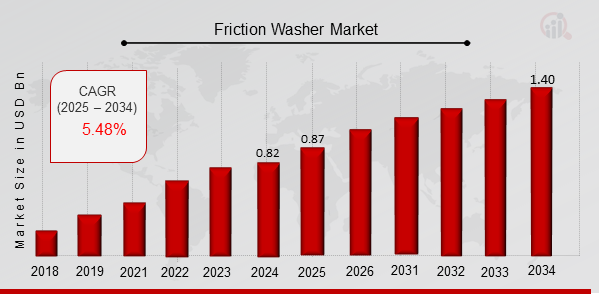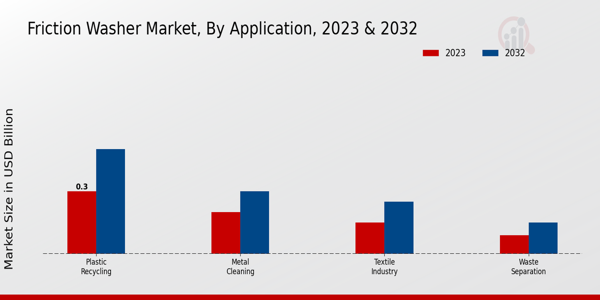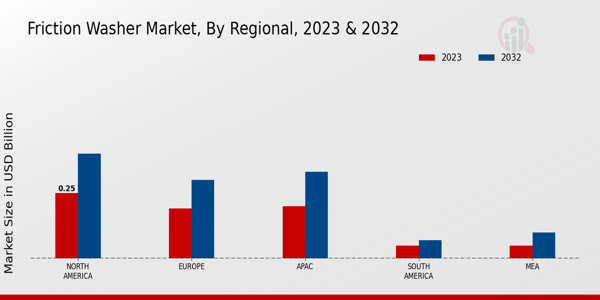Friction Washer Market Overview
As per MRFR analysis, the Friction Washer Market Size was estimated at 0.82 (USD Billion) in 2024. The Friction Washer Market Industry is expected to grow from 0.87 (USD Billion) in 2025 to 1.40 (USD Billion) till 2034, at a CAGR (growth rate) is expected to be around 5.48% during the forecast period (2025 - 2034).
Key Friction Washer Market Trends Highlighted
The Friction Washer Market is experiencing significant growth due to several key market drivers. The increasing demand for recycled materials in various industries is pushing manufacturers to adopt efficient cleaning processes. Friction washers play a crucial role in the recycling sector by effectively removing contaminants from plastic waste, thereby enhancing the quality of recycled materials. Furthermore, the rising awareness around environmental sustainability is encouraging companies to invest in technologies that reduce waste and improve recycling yields. As industries move towards greener practices, the adoption of friction washers is becoming a vital part of the production processes across sectors.There are various opportunities to be explored within this market. The growing trend of circular economy practices presents avenues for innovation in friction washer designs that enhance efficiency and performance. Additionally, developing regions are witnessing an increase in plastic production, leading to a higher volume of waste that needs to be processed. Companies can capture market share by tailoring their products to meet the unique needs of these emerging markets. Collaborations and partnerships with recycling facilities can also drive growth and widen the customer base for friction washer producers. In recent times, there has been a noticeable trend towards automation and digital solutions in manufacturing.Smart friction washers equipped with IoT capabilities streamline operations, monitor performance in real time, and reduce downtime. This automation trend not only improves efficiency but also appeals to industries focused on precision and quality control. Moreover, manufacturers are increasingly focusing on developing energy-efficient models, which not only help in cost reduction but also align with global efforts to minimize carbon footprints. These emerging trends indicate that the friction washer market is not just about cleaning plastic but is also becoming integral in the commitment to sustainability and technological advancement.

Source: Primary Research, Secondary Research, MRFR Database and Analyst Review
Friction Washer Market Drivers
Increased Demand for Sustainable Waste Management Solutions
The Friction Washer Market Industry is witnessing a significant surge in demand for sustainable waste management solutions amidst heightened environmental awareness. Companies across various sectors are striving to adopt practices that minimize waste and promote recycling. This shift toward sustainability has become a critical driver for the friction washer market, as the technology offers efficient cleaning and drying of plastic materials, making them ready for reuse.With rising regulations concerning plastic waste management and a growing emphasis on recycling, industries are increasingly investing in friction washer technology to optimize their processes. This investment not only supports their commitment to the environment but also enhances operational efficiency, driving the growth of the Friction Washer Market Industry. The ability of friction washers to handle various materials effectively allows businesses to reduce their carbon footprint while also complying with environmental standards.As industries prioritize sustainability, the friction washer market is set to experience substantial growth, bolstered by innovations in technology aimed at achieving cleaner production cycles.
Technological Advancements in Recycling Processes
The Friction Washer Market Industry is experiencing growth driven by remarkable technological advancements in recycling processes. Innovations in friction washer design and technology have enhanced their efficiency and versatility. These advancements allow friction washers to process different types of plastics and improve the overall cleaning results, making them a preferred choice in the recycling sector. As recycling operations become more sophisticated, businesses are seeking equipment that can keep pace with these changes, leading to an increase in the demand for state-of-the-art friction washers.
Growing Industrialization and Urbanization
The ongoing trends of industrialization and urbanization are significant factors driving the growth of the Friction Washer Market Industry. As cities expand and industries proliferate, the generation of plastic waste has also increased substantially. To address this growing challenge, industries are turning to friction washers for effective waste management. By utilizing these machines, companies can ensure that their recycled materials meet high standards of cleanliness and quality, facilitating the reuse of plastics in various applications.
Friction Washer Market Segment Insights:
Friction Washer Market Application Insights
The Friction Washer Market revenue is largely driven by its applications across various sectors, contributing significantly to market growth. In 2023, the market valuation stands at 0.74 USD Billion and is expected to reach 1.2 USD Billion by 2032, indicating a progressive demand for friction washers in crucial industries such as Plastic Recycling, Metal Cleaning, Textile Industry, and Waste Separation. The distribution of Friction Washer Market data reveals that Plastic Recycling holds a dominant position with a valuation of 0.3 USD Billion in 2023, increasing to 0.5 USD Billion in 2032, underlining its importance in enhancing recycling processes and promoting sustainability. This application's significance lies in its ability to efficiently clean and process plastic waste, which is pivotal as global attention shifts towards mitigating plastic pollution. Following closely, the Metal Cleaning segment generated a market value of 0.2 USD Billion in 2023, projected to rise to 0.3 USD Billion by 2032. The consistent demand for metal components across various industries drives the need for effective cleaning solutions, thus reinforcing the relevance of friction washers in maintaining production efficiency. The Textile Industry, valued at 0.15 USD Billion in 2023 and anticipated to grow to 0.25 USD Billion by 2032, showcases a growing recognition of the need for cleanliness in textile production, promoting higher quality outputs while minimizing waste as sustainability becomes increasingly critical. Moreover, Waste Separation, while smaller in valuation at 0.09 USD Billion in 2023, with an expected increase to 0.15 USD Billion by 2032, plays a crucial role in environmental management. This segment underscores the transition towards eco-friendly practices, where the use of friction washers aids in the efficient separation and cleaning of waste, thereby enhancing recycling rates. The overall Friction Washer Market Statistics indicate that these applications are integral to various industries, reflecting a compound focus on sustainability, cleanliness, and efficient resource management. As sectors evolve and prioritize environmental sustainability, opportunities for growth within these segments become evident, further solidifying the market's expansion potential in the coming years.

Source: Primary Research, Secondary Research, MRFR Database and Analyst Review
Friction Washer Market End Use Insights
The Friction Washer Market is experiencing steady expansion, driven largely by its diverse end use applications, including Manufacturing, Automotive, Construction, and Food Processing. In 2023, the market reflected a value of 0.74 billion USD, showcasing its robust growth trajectory. The manufacturing sector represents a significant portion of the market, as friction washers are essential for processing materials efficiently and maintaining equipment. Similarly, in the automotive industry, friction washers play a crucial role in ensuring vehicle performance and safety, thus dominating this segment.The construction sector relies on friction washers for efficient waste management and material recycling, contributing positively to sustainability efforts. The food processing industry requires high hygiene standards, where friction washers are integral in cleaning and recycling processes. The contributions of these various domains emphasize the versatility and necessity of friction washers, cementing their importance in the Friction Washer Market segmentation. The market growth is expected to be influenced by increasing industrial activities and advancements in recycling technologies.
Friction Washer Market Friction Washer Type Insights
The Friction Washer Market revenue for 2023 is valued at 0.74 Billion USD, showcasing a robust growth trajectory that underscores the vital role of friction washers in various industrial applications. Segmentation of the market reveals significant insights where Batch Friction Washers cater to specific requirements in recycling processes, allowing for optimized performance in handling large volumes of materials intermittently. Continuous Friction Washers, on the other hand, enhance efficiency by providing a constant flow, making them essential for industries requiring consistent processing of materials.Inline Friction Washers dominate this segment due to their integration into production lines, which offers seamless operation and reduced downtime. The prominence of these friction washer types can be attributed to their adaptability to various industrial demands and the rising emphasis on sustainability in manufacturing practices. Overall, the Friction Washer Market industry is influenced by factors such as the growing need for waste recycling and efficient material handling processes, leading to increased market growth. As the market expands, these friction washer types will continue to play a crucial role in meeting the evolving needs of diverse sectors.
Friction Washer Market Capacity Insights
In 2023, the Friction Washer Market is valued at 0.74 USD Billion, reflecting a growing trend in efficient washing technologies across various sectors. The Capacity segment plays a critical role in this market, encompassing varieties designed for different operational scales. Small Capacity friction washers are particularly important for small and medium-sized enterprises, offering flexibility and compactness ideal for limited spaces. In contrast, Medium Capacity friction washers cater to mid-level operations, balancing space and productivity.Large Capacity friction washers dominate heavy-duty applications across multiple industries, showcasing their ability to handle significant volumes efficiently. As the market continues to evolve, these distinctions inherent in Friction Washer Market segmentation contribute notably to the overall market growth, driven by increasing demand for eco-friendly waste management solutions and advancements in washing technology. The Friction Washer Market data reveals that innovations in manufacturing processes, alongside industry shifts towards sustainability, will further propel this sector.However, companies may face challenges such as equipment costs and competition, creating opportunities for emerging enterprises to innovate and capture market share. Overall, the Friction Washer Market statistics underscore a robust future for this industry.
Friction Washer Market Regional Insights
The Friction Washer Market is experiencing steady growth, reaching a valuation of 0.74 USD Billion in 2023, and is projected to grow to 1.2 USD Billion by 2032. Within the Regional landscape, North America stands out with a significant market valuation of 0.25 USD Billion in 2023, contributing to its status as a leading market for friction washers, driven by advanced manufacturing practices and recycling initiatives. Europe follows closely, valued at 0.19 USD Billion, a region that emphasizes sustainability in its industrial processes, which supports the demand for efficient cleaning solutions offered by friction washers.The APAC region, valued at 0.2 USD Billion, demonstrates substantial potential for growth due to increasing industrialization and expanding recycling facilities. In contrast, South America and MEA are smaller markets, valued at 0.05 USD Billion each in 2023, reflecting emerging markets with growing manufacturing and recycling sectors, although they are currently less dominant. The market growth in these regions presents significant opportunities for expanding market presence and addressing local needs in waste management and production efficiency.Overall, the Friction Washer Market segmentation reveals a diverse landscape with distinct characteristics and growth drivers across each region, contributing to the overall market dynamics.

Source: Primary Research, Secondary Research, MRFR Database and Analyst Review
Friction Washer Market Key Players and Competitive Insights:
The Friction Washer Market is characterized by a robust competitive landscape where various players strive to secure significant market shares through innovative solutions and improved processing technologies. This market encompasses companies that specialize in the manufacturing and distribution of friction washers, which play a critical role in the recycling of plastics and other materials. With the increasing emphasis on sustainability and environmental consciousness, the demand for efficient cleaning and washing systems has intensified. Companies in this sector are actively investing in research and development to enhance their product offerings, improve operational efficiency, and meet the evolving needs of various end-user industries. As a result, the competitive dynamics are shaped by factors such as technological advancements, pricing strategies, and geographic expansion efforts.NGR is a dominant player within the Friction Washer Market, known for its high-quality and efficient friction washing systems. The company has established a strong market presence characterized by its commitment to innovation and sustainability. NGR's friction washers are renowned for their superior cleaning performance, which effectively removes contaminants from recycled materials. This capability allows manufacturers to achieve high-quality recycled outputs suitable for various applications. The strengths of NGR lie in its advanced engineering and cutting-edge technology, which enhance the performance and longevity of its friction washer systems. Furthermore, NGR's focus on customer support and tailored solutions has solidified its reputation as a leading provider in the market, enabling it to foster long-term relationships with clients and maintain a competitive edge.BrennerEffect holds a significant position in the Friction Washer Market, distinguished by its unique approach to friction washing technology. The company specializes in innovative solutions that enhance the washing process, ensuring thorough cleaning of plastics and other materials for recycling applications. BrennerEffect's commitment to quality and performance is evident in its product design, which incorporates efficient features that optimize energy consumption while maximizing cleaning efficiency. The company's strengths are rooted in its technological expertise and an unwavering focus on providing effective solutions tailored to market needs. BrennerEffect's ability to adapt to market changes and respond to customer demands further supports its market presence, allowing it to enhance its competitive positioning and reputation in the friction washer sector.
Key Companies in the Friction Washer Market Include:
-
NGR
-
BrennerEffect
-
Shini Plastics Technologies
-
Conair
-
Erema
-
Steer Engineering
-
S+S Separation and Sorting Technology
-
Herbold Meckesheim
-
LindnerRecyclingtech
-
Sorema
-
Kreiger
-
Zhangjiagang Duxia Machinery
-
Plastics Revolution
-
Genox Machinery
Friction Washer Market Industry Developments
Recent developments in the Friction Washer Market indicate a growing trend in the adoption of advanced recycling technologies, particularly in companies such as Erema and NGR. These organizations are focusing on improving energy efficiency and waste reduction in their operations. BrennerEffect has recently expanded its product line, enhancing its competitive edge in the segment. On the acquisition front, Shini Plastics Technologies has announced the acquisition of a smaller firm specializing in recycling solutions, which aligns with its growth strategy to diversify its offerings. Additionally, Conair has entered a collaborative arrangement with Herbold Meckesheim to integrate new washing techniques that promote sustainability. Steer Engineering continues to innovate with new designs aimed at optimizing the processing of plastic waste, while S+S Separation and Sorting Technology is seeing an increase in demand for its systems as more brands seek eco-friendly manufacturing solutions. The overall market valuation for these companies is rising, driven by increased regulatory pressures for recycling and a heightened focus on sustainability among consumers. The collective efforts of these key players suggest a vigorous development phase in the Friction Washer Market, influenced by both technological advancements and strategic partnerships.
Friction Washer Market Segmentation Insights
-
Friction Washer Market Application Outlook
-
Plastic Recycling
-
Metal Cleaning
-
Textile Industry
-
Waste Separation
-
Friction Washer Market End Use Outlook
-
Manufacturing
-
Automotive
-
Construction
-
Food Processing
-
Friction Washer Market Friction Washer Type Outlook
-
Friction Washer Market Capacity Outlook
-
Small Capacity
-
Medium Capacity
-
Large Capacity
-
Friction Washer Market Regional Outlook
-
North America
-
Europe
-
South America
-
Asia Pacific
-
Middle East and Africa
| Report Attribute/Metric |
Details |
|
Market Size 2024
|
0.82 (USD Billion)
|
|
Market Size 2025
|
0.87 (USD Billion)
|
|
Market Size 2034
|
1.40 (USD Billion)
|
|
Compound Annual Growth Rate (CAGR)
|
5.48 % (2025 - 2034)
|
|
Report Coverage
|
Revenue Forecast, Competitive Landscape, Growth Factors, and Trends
|
|
Base Year
|
2024
|
|
Market Forecast Period
|
2025 - 2034
|
|
Historical Data
|
2020 - 2024
|
| Market Forecast Units |
USD Billion |
| Key Companies Profiled |
NGR, BrennerEffect, Shini Plastics Technologies, Conair, Erema, Steer Engineering, S+S Separation and Sorting Technology, Herbold Meckesheim, LindnerRecyclingtech, Sorema, Kreiger, Zhangjiagang Duxia Machinery, Plastics Revolution, Genox Machinery |
| Segments Covered |
Application, End Use, Friction Washer Type, Capacity, Regional |
| Key Market Opportunities |
Growing demand for recycling solutions, Expanding plastic manufacturing industries, Innovations in energy-efficient technologies, Increasing environmental regulations, Rising demand for sustainable practices |
| Key Market Dynamics |
Increasing recycling demand, Technological advancements, Stringent environmental regulations, Growing plastic processing industry, Rising industrial automation |
| Countries Covered |
North America, Europe, APAC, South America, MEA |
Frequently Asked Questions (FAQ) :
The Friction Washer Market is expected to reach a value of 1.40 USD Billion by 2034.
The expected CAGR for the Friction Washer Market from 2025 to 2034 is 5.48%.
North America is anticipated to dominate the Friction Washer Market with a projected value of 0.4 USD Billion in 2032.
The market size for the Plastic Recycling application is expected to be 0.5 USD Billion by 2032.
The Textile Industry application segment is expected to reach a market value of 0.25 USD Billion by 2032.
Key players in the Friction Washer Market include NGR, BrennerEffect, and Erema, among others.
The Friction Washer Market is valued at 0.25 USD Billion in North America for the year 2023.
The Metal Cleaning application segment is anticipated to grow to 0.3 USD Billion by 2032.
The Waste Separation application is expected to reach a market size of 0.15 USD Billion by 2032.
South America is expected to have the smallest market size in 2032, reaching 0.07 USD Billion.

















